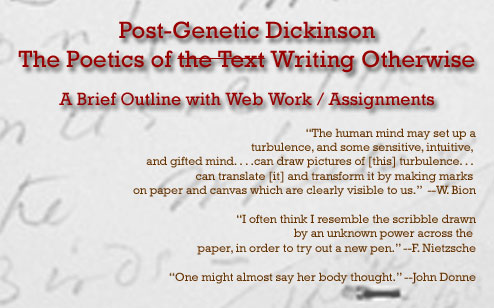

2. Dickinson expressed herself on the surfaces of her manuscripts in a series of legible signs and illegible marks. Which of these marks and symbols do we know how to decipher and interpret; which ones pose problems of interpretation? How does the complex, ambiguous, and charged interplay of "intentional" and "accidental" traces on Dickinson's manuscripts make us strongly aware of the writer--of her desires, choices, decisions--and of the degree to which the writer remains unapproachable?
3. What narratives of Dickinson's living hands emerge from a microgenetic study of her manuscripts--both fair- and rough-copies?
4. By the nineteenth century manuscripts had, by and large, lost their communicating and circulating functions to become "the personal trace of an individual creation." In general, the manuscript appears as a space of creation rather than communication. How do Dickinson's textual practices both confirm and/or challenge this conception of the manuscript?
5. In "All Writing is Drawing," Serge Tisseron remarks, "the inscriptive process is above all the hand exploring a given space and organizing it according to its own possibilities." How does Dickinson use the space of the paper? How does she "invest the page as a metaphor for the container of thoughts"?
6. How does a genetic approach to Dickinson's manuscripts impact the reading process?